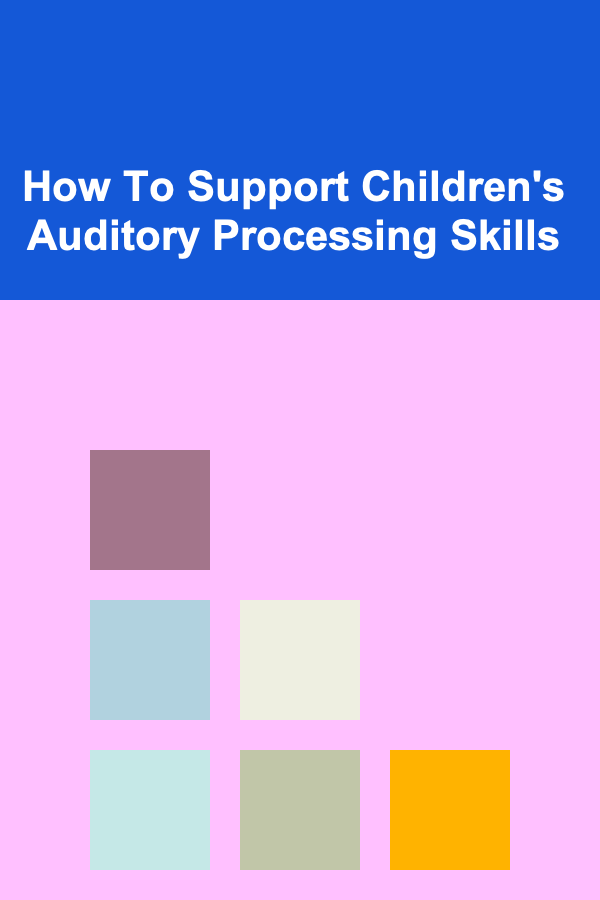
How To Support Children's Auditory Processing Skills
ebook include PDF & Audio bundle (Micro Guide)
$12.99$7.99
Limited Time Offer! Order within the next:

Auditory processing refers to the brain's ability to interpret and make sense of sounds, including speech. Children with auditory processing challenges often struggle to understand spoken language, which can impact their academic performance, social interactions, and emotional well-being. It's crucial to recognize the signs of auditory processing issues early and provide appropriate support. This article explores how to support children's auditory processing skills through various strategies and interventions, ensuring that they can thrive in a world full of sounds and information.
What is Auditory Processing?
Auditory processing is the process by which the brain receives, interprets, and responds to sounds. This includes distinguishing between different sounds, recognizing patterns, and understanding speech in noisy environments. Children with auditory processing disorder (APD) may hear sounds, but their brains have difficulty processing these sounds in a meaningful way. APD is not related to hearing loss, but rather to how the brain interprets sounds.
Symptoms of Auditory Processing Disorder
Auditory processing disorder can manifest in a variety of ways. Some common signs that a child might be experiencing difficulties with auditory processing include:
- Difficulty following verbal instructions: Children may have trouble following multi-step directions or might seem like they don't hear you, even though they do.
- Struggles with speech clarity: They may have difficulty distinguishing similar-sounding words or understanding speech when there's background noise.
- Poor listening in noisy environments: Children with APD often have trouble focusing on a conversation in a noisy room or classroom.
- Difficulty with reading and spelling: Since auditory processing affects the ability to distinguish sounds, children may struggle with phonemic awareness, which is critical for reading and writing.
It's important to remember that auditory processing difficulties can vary from one child to another, and children may show different signs and symptoms depending on the severity of their condition.
The Role of Early Intervention
Supporting children with auditory processing difficulties early can make a significant difference in their ability to develop listening and comprehension skills. Early intervention helps children acquire effective strategies to cope with challenges, allowing them to progress academically and socially. Without support, these children may face ongoing difficulties in school and at home, which can impact their self-esteem and emotional well-being.
Collaboration Between Parents, Teachers, and Specialists
Effective support for children with auditory processing difficulties requires collaboration between parents, teachers, and specialists. Teachers can implement strategies in the classroom, while parents can create a supportive environment at home. Speech-language pathologists, audiologists, and psychologists are important professionals who can assess the child's auditory processing skills and recommend specific interventions.
By working together, a tailored plan can be developed to address the child's individual needs, providing targeted support that fosters growth and development.
Strategies for Supporting Auditory Processing Skills
Several strategies can help improve a child's auditory processing abilities. These strategies focus on creating an environment that supports better listening and communication and on teaching children specific skills to overcome challenges. The following are some practical ways to support children's auditory processing skills.
1. Creating a Structured Environment
A structured environment can significantly reduce distractions and improve a child's ability to focus on listening. The classroom and home settings should be organized in a way that minimizes background noise and promotes attention to sounds.
Tips for Creating a Structured Environment:
- Reduce background noise: Turn off any unnecessary devices, such as TVs or radios, while the child is engaged in activities that require listening. In classrooms, seat the child away from windows, doors, and noisy areas.
- Use visual aids: Complement auditory information with visual cues. For example, use pictures, written instructions, and gestures to reinforce what is being said.
- Clear communication: Speak clearly and at a moderate pace. Avoid mumbling or speaking too quickly, as children with auditory processing challenges may need extra time to process information.
- Use repetition: Repeat key information to ensure the child has understood the message. Allow them to ask for clarification when needed.
2. Implementing Active Listening Techniques
Active listening skills are crucial for children with auditory processing difficulties. These techniques can help children focus on the sounds they need to hear and process the information more effectively.
Active Listening Strategies:
- Use a "listening body": Encourage children to use their whole body to focus on listening. This means sitting still, facing the speaker, and maintaining eye contact.
- Encourage good posture: Proper posture, such as sitting upright with both feet on the floor, can help the child stay focused and engaged.
- Ask comprehension questions: After giving instructions or reading a story, ask the child to repeat the information in their own words or answer specific questions. This helps ensure they are processing the information correctly.
- Practice sound discrimination: Play games where children need to differentiate between various sounds or identify similar and different sounds. For example, you can play a "sound match" game where children listen to two sounds and decide if they are the same or different.
3. Incorporating Multisensory Learning
Children with auditory processing challenges may benefit from multisensory learning techniques that engage more than just the auditory sense. By using visual, tactile, and kinesthetic cues, children can better understand and retain the information being presented.
Multisensory Techniques for Learning:
- Visual supports: Use charts, diagrams, and pictures to reinforce what is being taught. Visual aids can help children associate sounds with symbols or words.
- Kinesthetic activities: Engage children in physical activities that require them to move their bodies while listening. This could include following a dance routine, using sign language, or incorporating interactive games.
- Hands-on learning: Incorporate manipulatives such as blocks, puzzles, or objects that children can touch and move. This helps children connect the sounds they hear with the physical world.
4. Practicing Auditory Discrimination Skills
Auditory discrimination is the ability to distinguish between different sounds. Children with auditory processing difficulties often struggle with this skill, so it is important to practice distinguishing between similar sounds in different environments.
Activities for Improving Auditory Discrimination:
- Sound matching: Provide the child with pairs of sounds and ask them to match similar sounds. For example, use instruments like a tambourine and a bell, and have them listen for the differences.
- Rhythm and music: Music is a powerful tool for improving auditory skills. Encourage children to play rhythm games, clap to a beat, or listen to songs with repeating patterns. Music can also help children improve their listening and memory skills.
- Minimal pairs: Present two words that differ by just one sound, such as "bat" and "pat," and ask the child to identify the difference. This helps them improve sound recognition and comprehension.
5. Using Technology and Assistive Devices
Advancements in technology offer various tools and devices that can support children with auditory processing challenges. These tools can help reduce distractions, enhance sound clarity, and assist with specific auditory skills.
Technology and Devices for Auditory Support:
- FM systems: An FM system is a personal amplification device that can be used in classrooms. The teacher wears a microphone, and the child wears a receiver, which helps amplify the teacher's voice and reduces background noise.
- Noise-canceling headphones: These headphones can help children concentrate by blocking out extraneous noise. They can be particularly helpful when a child is trying to focus in a noisy environment.
- Interactive apps: Several apps are designed to help children practice auditory processing skills, such as distinguishing sounds, following instructions, or playing auditory memory games.
6. Supporting Emotional and Social Development
Children with auditory processing difficulties may become frustrated if they cannot understand or follow conversations easily. This frustration can lead to feelings of isolation and anxiety. It's important to create a supportive emotional environment and help children develop social skills.
Emotional and Social Support:
- Positive reinforcement: Celebrate successes, no matter how small. Praise the child for their efforts and progress, which can boost their confidence.
- Peer support: Encourage social interaction with peers who are patient and understanding. Group activities can help children practice listening and communication in a supportive setting.
- Teach coping strategies: Teach the child strategies to cope with situations where they may struggle with auditory processing, such as asking for repetition or using visual cues.
7. Professional Help and Speech Therapy
In some cases, a professional evaluation may be necessary to assess the extent of a child's auditory processing difficulties. Speech-language pathologists (SLPs) and audiologists are trained to diagnose and treat auditory processing disorders. They can design specific interventions that address the child's unique needs.
Professional Interventions:
- Speech therapy: SLPs can work with children to improve their listening and speech skills. Therapy may include exercises to strengthen auditory memory, comprehension, and discrimination.
- Auditory training: Auditory training programs are designed to improve the brain's ability to process sounds more effectively. These programs often include listening exercises that help children improve their auditory skills.
- Family and teacher training: Professionals can also provide training to parents and teachers, teaching them how to create a supportive environment and use effective communication strategies.
Conclusion
Supporting children's auditory processing skills is a multifaceted approach that involves creating a structured environment, using effective listening strategies, incorporating multisensory learning, and providing emotional and social support. By working closely with children, their families, and professionals, it is possible to help children overcome auditory processing challenges and improve their ability to listen, understand, and communicate. Early intervention and ongoing support can make a significant difference in a child's academic and social success, helping them develop the skills they need to navigate a world filled with sounds and language.

Elevating Your Brand with Data-Driven Decisions
Read More
How to Incorporate Personalized Touches into Your Holiday Decorations
Read More
How to Learn from Successful Investors
Read More
How to Organize a Community Garden Project
Read More
How to Set Up a Dessert Bar for Your Home Party
Read More
How to Use Mnemonics for Vocabulary
Read MoreOther Products

Elevating Your Brand with Data-Driven Decisions
Read More
How to Incorporate Personalized Touches into Your Holiday Decorations
Read More
How to Learn from Successful Investors
Read More
How to Organize a Community Garden Project
Read More
How to Set Up a Dessert Bar for Your Home Party
Read More